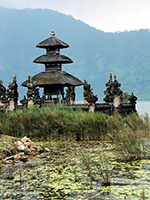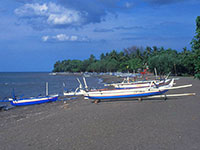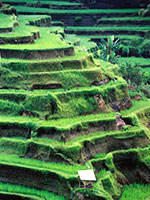


TOUR 2 – BEDUGUL ~ SINGARAJA
Duration: Approx 10 Hours
Rate: 1-3 Persons US$ 65 • 4-6 Persons US$ 70
BALI ULUN DANU BERATAN TEMPLE
Bali Ulun Danu Beratan Temple is a temple dedicated to the goddess of the lake is Ida Batari Dewi Ulun Danu on the edge of a huge crater. The dominant shrines are Meru’s (pagodas) dedicated to the lake goddess and the gods of Mount Batur and Mount Gunung Agung, the largest volcano in Bali. The sight and cool atmosphere of the Bali uplands have made the lake and this temple a favourite sightseeing and recreational spot as well as a frequently photographed site. Ulun Danu Beratan Temple, literally ‘the source temple of Lake Beratan’, is easily the island’s most iconic sanctuary sharing the scenic qualities with the seaside temples of Uluwatu Temple and Tanah Lot Temple. The smooth reflective surface of the lake surrounding most of the temple’s base creates a unique floating impression, while the mountain range of the Bedugul region encircling the lake provides the temple with a scenic backdrop.
BEDUGAL MARKET
Bali Candi Kuning Market is the name of traditional fruit and vegetable market situated in the mountain area of Bedugul Bali. It is strategically located beside of the main road from Denpasar to Singaraja and many visited by tourists or local people who pass this market. The fruits and vegetable are displayed look fresh due to it supplied from the local agriculture field surrounding area. Candi Kuning Market can be visited when passing main road from or to Singaraja.
GITGIT WATERFALL
Bali Gitgit Waterfall is a beautiful tourist destination in north part of Bali. Gitgit waterfall is located in the plateau area with the height about 35 meters and it is surrounded by tropical tree and emits the constantly natural water debit during the year. Waterfall voice around the charming nature was amazing and it was the separate attraction which can be enjoyed by each visitor who comes to visit. There are some plantations protecting the rainforest around the waterfall and in this place we often met the wild monkey to get the water from this waterfall.
SINGARAJA
Singaraja the Old Dutch capital, is the world on the other side of the mountains. It was also once Bali’s main harbor but in recent years the harbor has become silted up as it has been shifted west to the more sheltered Labuan Celukbawang for the major export and import business. The north coast of Bali has been inhabited for centuries with local villages mentioned in the 10th century inscriptions, the ascendancy of the area only really began at the end of the 16th century, when Ki Gusti Ngurah Panji Sakti founded Buleleng, and in 1604 built a new palace called Singaraja. Buleleng has a rugged and, in places, dramatic landscape, as the northern flanks of the mountains drop steeply towards long, sweeping black-sand beaches. The land is dry and parched towards the east, where villages are widely spread out and the lava flows from the last eruption of mount Agung are still visible. Most tourists however come to the north for the burgeoning beach resort of LOVINA, west of Singaraja, a great place to relax or to use as a base for exploring the temples, hot springs and inland scenery of the region.
LOVINA BEACH & DOLPHIN WATCHING
Lovina Beach is one of the famous tourist destination in northern part of Bali which own beautiful of calm sea water, blackish chromatic sand and the sea with its dolphin. One of the favorite fascinations in Lovina is dolphin watching tour. Hundreds of dolphins can be seen in the morning time around 1 km offshore. We can see the dolphin attractions in this place like jumping. It is not fail to draw if the tourist has the time to see the sunset here.
BANJA HOT SPRING
Banjar Hot Spring is a nature hot wellspring from the ground and it is believed can heal the disease. Its water is accommodated at one small swimming pool encircled by unique rural nature. This hot wellspring source is predictably built since of hundreds of year ago and since the Japanese colonize the Indonesia, this place has developed into three pools to relocate the water for taking a bath. The Japanese had also developed its military officer resort close to this area. Having bathing in the heat water containing the brimstone, it will be able to heal the skin disease. Now this place is opened for tourist who can use this bathing place to swim in hot pool and also enjoy the water fall. Enjoying the hot water fall, we can feel like squeezing, especially at pool equipped by the shower that can make the body refresh and relaxed.
PUPUAN RICE TERRACE
Bali Pupuan Rice Terrace is beautiful rice terrace located in the western part of Bali, a place to fill your eyes with awesome memories of great landscape accompanied by no one other than the friendly local farmers. Pupuan Rice Terrace is best enjoyed early in the morning or late in the afternoon on a clear day. When rainy, fog usually follows the rain and obscures the whole village. With the arrival of the planting season, the local cultivators start plowing their fields adding traditional culture to the scenery. The cultivators have retained their old way of cultivating their land with the help of buffalo. As padi grows profusely in the area, a deep green covers the landscape, resembling a vast emerald rug laid on the slopes of the hills. The cultivators of these crops share an intimate relationship with nature. At harvest time, the cultivators cut the paddy with traditional equipment called anggapan. Standing in rows, they sing while they glean their harvest.